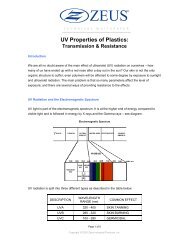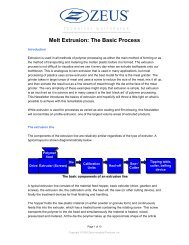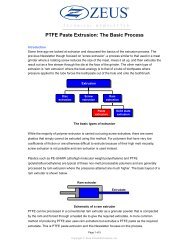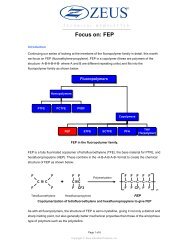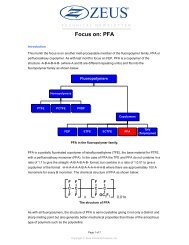Crystallinity in Plastics - Zeus Industrial Products, Inc.
Crystallinity in Plastics - Zeus Industrial Products, Inc.
Crystallinity in Plastics - Zeus Industrial Products, Inc.
Create successful ePaper yourself
Turn your PDF publications into a flip-book with our unique Google optimized e-Paper software.
Examples of crystall<strong>in</strong>e polymers are PP, PE (all varieties but some more so than others), PA<br />
and POM. As a rule, any polymer that is translucent or opaque <strong>in</strong> the natural form is a<br />
crystall<strong>in</strong>e polymer.<br />
The degree of crystall<strong>in</strong>ity<br />
Not all polymers crystallize to the same degree. All polymers have some degree of<br />
crystall<strong>in</strong>ity except for amorphous polymers. <strong>Crystall<strong>in</strong>ity</strong> can vary between 0% (an<br />
amorphous polymer) and 80% (a highly crystall<strong>in</strong>e polymer).<br />
There are also a number of variables present <strong>in</strong> polymer structure that affect crystall<strong>in</strong>ity, and<br />
they are:<br />
� Polymer cha<strong>in</strong> length: Molecular weight is a measure of how long the polymer<br />
backbone cha<strong>in</strong> is. If the molecular weight is high, then the polymer backbone cha<strong>in</strong><br />
is long and the degree of crystall<strong>in</strong>ity is reduced. This is illustrated by the behavior of<br />
PE. HDPE molecules are up to 100 times longer than LDPE molecules. As a result,<br />
the degree of crystall<strong>in</strong>ity of HDPE is much lower than LDPE.<br />
� Stereoregularity: This is a measure of how the mers (the repeat units <strong>in</strong> the polymer)<br />
are arranged <strong>in</strong> the polymer backbone cha<strong>in</strong>. Isotactic materials have the mers<br />
connected together <strong>in</strong> a s<strong>in</strong>gle repeated manner, syndiotactic materials have the<br />
mers connected together <strong>in</strong> a regularly repeated but different manner, and atatic<br />
materials have the mers connected together <strong>in</strong> a random manner. Atactic materials<br />
are generally amorphous because of the lack of polymer cha<strong>in</strong> order, whereas<br />
isotactic and syndiotactic polymers are typically crystall<strong>in</strong>e because of the high<br />
degree of polymer cha<strong>in</strong> regularity. This effect can be used to <strong>in</strong>crease the properties<br />
of some polymer, such as PP, by encourag<strong>in</strong>g crystallization through the use of<br />
stereospecific forms of the material.<br />
� Polar groups: Some polymers have polar groups present along the ma<strong>in</strong> polymer<br />
cha<strong>in</strong>, e.g. the CO group is present <strong>in</strong> many amorphous polymers. These groups<br />
repel each another and prevent the formation of crystall<strong>in</strong>e structures. Equally, some<br />
materials, such as the polyamides, form crystals very easily because of the attraction<br />
between sections of the ma<strong>in</strong> backbone cha<strong>in</strong>.<br />
� Cha<strong>in</strong> branch<strong>in</strong>g: The degree of branch<strong>in</strong>g on the ma<strong>in</strong> backbone cha<strong>in</strong> will affect the<br />
ability to crystallize. Highly branched polymers will generally be less crystall<strong>in</strong>e than<br />
l<strong>in</strong>ear polymers due to the presence of long branches.<br />
The rate of crystallization<br />
The rate of crystallization is dependent on temperature, of which there are two significant<br />
po<strong>in</strong>ts:<br />
� Tg - The glass transition temperature. Below Tg, there is virtually no molecular motion<br />
on a local scale. Polymers have many of the properties associated with ord<strong>in</strong>ary<br />
organic glasses <strong>in</strong>clud<strong>in</strong>g hardness and stiffness.<br />
Page 4 of 9<br />
Copyright ©2007-2010 <strong>Zeus</strong> <strong>Industrial</strong> <strong>Products</strong>, <strong>Inc</strong>.




